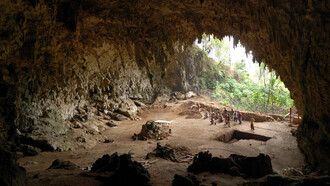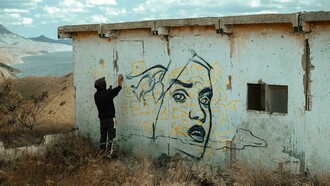Threads become entangled, occasionally they brittle and lighten up as if to connect the mental universe that exists within me to the cosmos outside.
(Chiharu Shiota, Shiota Chiharu: The Soul Trembles, Mori Art Museum)
“Drawing in the air” is a phrase uttered by profoundly intense artist Chiharu Shiota to describe how weaving threads in her life-size installations expands her mind and soul from a limited two-dimensional canvas into an infinite three-dimensional universe. Since her preliminary painting classes at Kyoto Seika University, Chiharu had always felt a sense of incompleteness in two-dimensional expressions. While struggling to grapple with her existence and own cloud of limitations in Australia as an exchange student, she finally discovered her perpetual realm in the art of weaving threads as a symbol of connected souls. This astonishing lacework would appear as a mantle over boats, chairs, clothes, suitcases, shoes, or just about any type of object that has passed through not only Chiharu’s but every person’s life story, sewing tiny poems of self-awareness.
Running until October 27th this year at the Mori Art Museum, Tokyo, Shiota Chiharu: The Soul Trembles delivers the largest-ever solo exhibition of this captivating artist who has been fascinating art enthusiasts from all over the world across Europe, Scandinavia, Russia, USA, South America, Middle East, Australia and Asia, from early exhibitions since 1994 to the present. The vast exhibition at the Mori Art Museum is itself an explosive confession of Chiharu’s most intimate thoughts and emotions of liberation, endurance, uncertainty, emptiness, indignation, desire, freedom, sense of belonging, death, and interrelation with nature.
Before reaching the entrance of the exhibition space, you are boldly confronted by a suspended installation of 65 boats in interlaced white wool, wire and rope drooping over you from eleven meters high like an inverted ocean. Where Are We Going?, was originally exhibited in Paris in 2017. The boat is one of Chiharu’s metaphorical objects that she often incorporates in her visual imagery. It represents an “unknown destination, crossing a sea of experiences, emotions, encounters, and memories” that likewise, link to uncertain lives intertwining (by the white yarns) the past with the future. Standing beneath the hanging vessels truly creates the enigma of what lies underneath a moving life and where it is headed.
Chiharu expresses the parallel thought as well in Uncertain Journey, perhaps the most popular hall in the exhibition filled with a mesh of red woven yarns stretched from every corner of the space and wrapping black framed boats. Walking under and around the crimson red canopy carries sensations of soul-searching and belongingness at the same time—the red color, representing blood that flows through the complexity of our mind and bodily system, and connecting each human vessel (boat) with each other. Red and black are Chiharu’s major color representations of human relationships; black being the massive breadth of the immeasurable cosmos. Red, in particular, stems from deep significances in Japanese culture, traced in legends that pertain to the vein of destiny.
Many of Chiharu’s works embrace pages from her childhood memories. Another enormous installation of webbed threads, this time in black, seems to lift empty chairs and a deserted piano to the barren sky. In Silence re-enacts Chiharu’s experience at nine years old during a fire at her neighbor’s house, where a piano was found sitting in the middle of the burning essence. For Chiharu, the scorched black cloud “existed as souls without a tangible form. The more you think about them, the more their sounds disappear from my mind”1. The stage may set off a disturbing smell of eeriness or gloom, yet dark honesty at the same time.
In her primal visions of death, visiting her ancestors’ graveyards as a child already planted the seeds of dread and rhetoric of the after-life. The exhibition displays a video art of the artist rolling her body on mud, rubble and the soil of fate, sinking herself beneath the earth like pulling weeds of death. Watching the video is both moving and surreal. Since she was diagnosed with cancer, this painful reality has become Chiharu’s “tribulation to create honest works”2. She has expressed such private sentiments in During Sleep, a performance and installation of metal hospital beds joined to each other by black wool threads, capturing the image of a “sleeping person occupying the gap between dream and reality”3. One cannot help but genuinely reflect on the fragile seconds that quickly tick away and the helpless desire to make meaning of them.
Chiharu herself is a product of numerous destinations of uncertainty, as she often calls them, having moved from Osaka (where she was born) to Kyoto, Australia, and Germany, where she studied under the Polish artist Magdalena Abakanowicz, enrolled at the University of Fine Arts Hamburg, and learned performance art from Marina Abramovic at Braunschwieg University of Art. Berlin has since become her niche, and has also showered her with astronomic impact especially after the collapse of the Berlin wall. In Inside-Outside Chiharu relentlessly collected windows to attach them to each other like boundaries between the inside and the outside, and the missing link that separates the east and the west.
Further illustrations of unknown destinations are depicted in *Accumulation—Searching for the Destination, the grand suspension of suitcases tied by red ropes—each luggage symbolizing a person’s life bundled in memories. The enthralling beauty of this panoramic view lies in the ascending direction of the suitcases as though they are being carried off to the sky. It escalates sensibilities that ponder on people’s departures and what makes them leave and return.
Shiota Chiharu: The Soul Trembles has opened the human eye to one’s personal confrontation with the essence of living, breathing material and nature, and incessantly creating tangible forms of memories and encounters that themselves exist as intangible emotions. Simultaneously, the artist proclaims the courage of cradling death as equal to life itself. “Both dying and living belong to the same dimension”4. Encompassing a dynamic span of 25 years of Chiharu’s works, the must-see exhibition collates not only installations, but also sculptures, video footages, photography, drawings, and performing art-related objects that usher the journey of life and liberation of the soul.
1 (Chiharu Shiota, Shiota Chiharu: The Soul Trembles, Mori Art Museum).
2,3,4 Ibidem.















